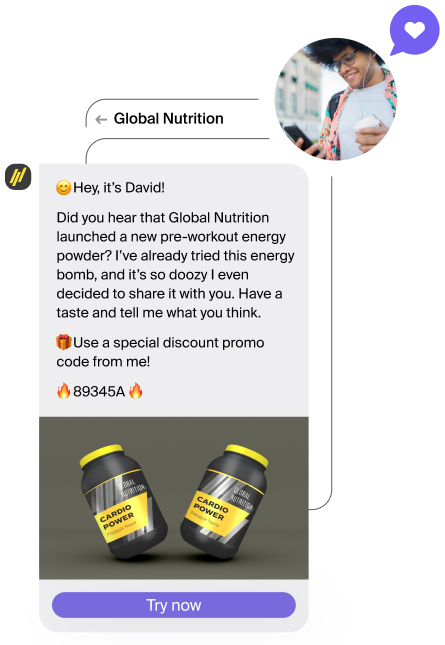In 2010, Eric Schmidt, the former CEO of Google, announced that the company would follow a “mobile-first” attitude in its product design. But what does mobile-first design truly mean and how did this shake up PC-based digital marketing?
The mobile-first rule means starting the product design from the mobile end and then expanding its features to create desktop and tablet versions.
Whether it’s shopping, self-care, entertainment or managing daily routines — smartphones have become an integral part of our everyday life. They are also the perfect platform for your multichannel marketing efforts. Imagine you own an online clothing store. Moving customers down the funnel towards a purchasing decision will be much easier since both your loyal and potential clients have access to a suite of various communication channels on their smartphones. They can place an order on your website or app, verify the account via SMS or email, track the order and receive push notifications from the app, and finally receive transactional messages, alerts, exclusive offers, and status updates via their favourite messengers. That’s why between March and August 2021, 79% of smartphone users preferred shopping online using their mobile devices.
And why is investing in mobile marketing a winning strategy in the context of mobile marketing trends 2022?
- Mobile internet usage has beaten desktop usage in 2016 (51.3% vs 48.7%). In 2021, almost 55% of users preferred accessing the world wide web from mobile devices.
- Users spend far more time on the internet from mobile ends: 155 minutes from phones vs 37 minutes from PCs daily.
- People purchase more mobile devices than computers (56%).
Not to fall behind, brands should keep abreast of the ongoing mobile marketing trends 2022. The primary trend is clear: mobile is king. But what specific areas and tools deserve your attention this year? Find the answer in our new article.
1. Keeping balance between personalisation and privacy
“Always eyes watching you and the voice enveloping you. Asleep or awake, indoors, or out of doors, in the bath or bed – no escape.”
G. Orwell, “1984”
A study by SmarterHQ revealed that 80% of frequent buyers only shop with brands that personalise the experience. However, personalisation can also heighten privacy concerns. Facebook’s recent leakage of personal user data led to a severe public outcry. No one would like to experience an invasion of privacy only to get a better customer experience: an irrelevant banner will not bring clicks but seeing an ad popping up after mentioning a brand in a conversation with a mate is unsettling. That’s why 2022 will be the time to pay attention to crafting that balance between privacy and personalisation. Therefore:
- Give preference to first-party data shared by the consumers;
- Avoid sensitive targeting criteria: health, wealth, religion, and politics;
- Do not track customers if they don’t want to be tracked, use analytics data.
2. Geoconquesting — the next level of location-based marketing
Location-targeted offers have proved to be a remarkably effective way of cutting through the marketing noise. Delivering ad messages that meet consumers’ needs at the right time in the right place will both make your customers’ life easier and increase your revenues. Restaurants, cafés, grocery stores, shopping and entertainment centres may benefit by using geofencing, geotargeting and finally — geoconquesting.
Geoconquesting is attracting customers away from competitors using location-based ads. These ads are sent to customers who are visiting or have visited a rival business.
For instance, Android device resellers can send targeted SMS to customers near Apple stores across the street to convince customers to buy Samsung smartphones instead. But to use geoconquesting successfully, you must have accurate and complete location data. The good news is that geo-data technologies are constantly evolving, and thus, the road is set to get smoother. According to Statista, targeted mobile advertising spendings in the United States will surpass 32 billion dollars by the end of 2023. Enhanced uses for geoconquesting are on the horizon in the near future.
3. Subscription economy is on rise
Spending on subscription services jumped more than 50% in lockdown. But first, what comes to your mind when you hear about subscription services? Netflix, YouTube, Spotify, and Amazon Prime? Yep, but those are only one side of the coin. According to Royal Mail Group, the UK subscription box market is set to be worth £1.8 billion by 2025.
A subscription box is a recurring, physical delivery of products.
Both the digital and physical product subscription economy is expected to boom in 2022. That creates a pool of opportunities for mobile marketing activities. To ensure the best possible customer experience, don’t forget to reach your subscribers regularly. Push notifications and transactional SMS are eating the world here as they are super convenient for delivering any status updates. A previously unavailable item is now in stock — receive a notification and add it to your box! To automate the entire process and make the customer experience fancier, you may try introducing a chatbot — an ongoing trend of recent years and the mobile marketing trend 2022.
4. Hybrid influencer marketing
Did you know that 49% of consumers depend on influencer recommendations? On top of that, 70% of teenagers trust them more than traditional celebrities. Influencer marketing has already become an integral part of social media like Facebook, Instagram, YouTube and TikTok. But the secret is that people can recognise their beloved bloggers far outside the platform where they follow them. The year 2022 will open room for creativity here, expanding the frontiers of the hybrid influencer marketing model. For instance, imagine you’re launching a campaign to introduce a new pre-workout energy powder. How do you get a big sales bump from this new product? Let’s say your company sponsors a popular fitness model David Laid. Of course, you can just keep paying him to promote your product on Instagram. But there are other ways — send subscribers a message on behalf of this influencer in Viber. This OTT is a perfect match here: emojis, images and interactive buttons will help humanise the communication. And customers will be surprised to receive a message from David (even if sent via your channel) in Viber — WOW effect as it should be!

Find more info on arranging a multichannel messaging campaign involving an influencer.
5. 5G
According to the recent Ericsson Mobility Report, 5G smartphone subscription worldwide is expected to surpass 1 billion in 2022. Marketers can expect that 5G will bring better targeting options. More connected devices mean more data flying around, and we can expect this technology will help create better advertising experiences. For example, Viber targeting capabilities today include geo, destination, device, carrier, dayparting, browser language, frequency capping, age, gender, messaging activity, caller activity, travelling, and behaviour. 5G should help these functions work even better so you can reach the maximum number of potential clients and save a penny. Quality 5G connection also brings more opportunities for geoconquesting mentioned previously.
2022 seems to become a promising year with many opportunities for marketers to fine-tune their mobile marketing mix, get even closer to their customers, and reap better results. Contact our reputable mobile messaging experts and get prepared for this brave new world!

